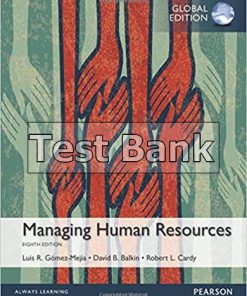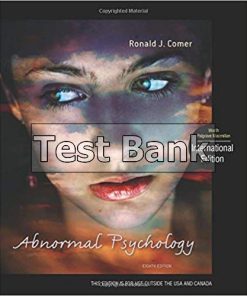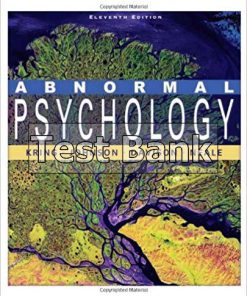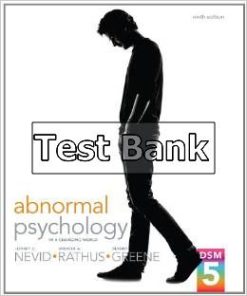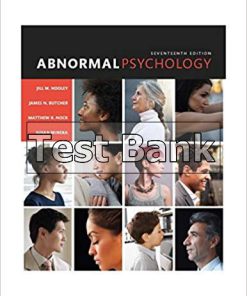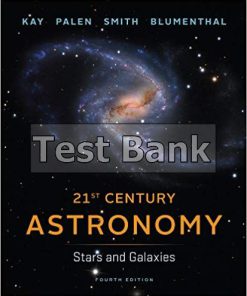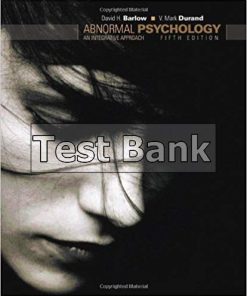Managing Human Resources 4th Edition Stone Test Bank
You may also like
Managing Human Resources 4th Edition Stone Test Bank
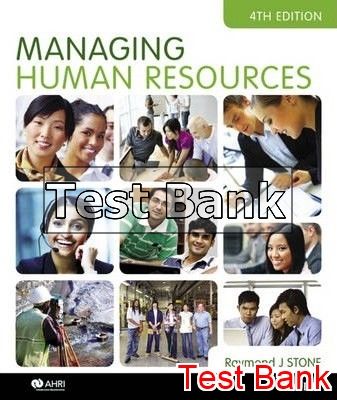
Product details:
- ISBN-10 : 0730302555
- ISBN-13 : 978-0730302551
- Author: Raymond J. Stone
Endorsed by the Australian Human Resources Institute (AHRI – thenational association representing human resource and peoplemanagement professionals), Managing Human Resources 4th editionpresents a concise coverage of key HRM topics typically taught in a12 or 13-week teaching semester. The 4th edition has beenthoroughly updated to reflect the impact of the Fair Work Act onthe employment relationship between employers and employees, aswell as on the work of HR professionals.
Table contents:
- Chapter 1 The Strategic Role of Human Resources Management
- Learning Outcomes
- 1.1 The Strategic Role of Human Resources Management
- 1.2 The Evolution of HRM
- 1.2.1 Critical Competencies for HR Professionals
- 1.2.1.1 Credible Activist
- 1.2.1.2 Culture and Change Steward
- 1.2.1.3 Talent Manager and Organizational Designer
- 1.2.1.4 Strategy Architect
- 1.2.1.5 Operational Executor
- 1.2.1.6 Business Ally
- 1.2.2 Measuring the Value of HR: Metrics
- 1.3 Professionalism in HRM
- 1.3.1 Ethics and Corporate Social Responsibility
- 1.4 Environmental Influences on HRM
- 1.4.1 External Environmental Influences
- 1.4.1.1 Economic Conditions
- 1.4.1.2 Labour Market Issues
- Increasing Workforce Diversity
- Generational Issues
- Education
- Non-Standard or Contingent Workers
- 1.4.1.3 Technology
- 1.4.1.4 Government
- 1.4.1.5 Globalization
- 1.4.1.6 Environmental Concerns
- 1.4.2 Internal Environmental Influences
- 1.4.2.1 Organizational Culture
- 1.4.2.2 Organizational Climate
- 1.4.2.3 Management Practices
- Chapter Summary
- MyLab Management
- Key Terms
- Review and Discussion Questions
- Critical Thinking Questions
- Experiential Exercises
- Chapter 2 The Changing Legal Emphasis: Compliance and Impact on Canadian Workplaces
- Learning Outcomes
- 2.1 The Legal Framework for Employment Law in Canada
- 2.1.1 Hierarchy of Employment Legislation in Canada
- 2.1.2 Tort Law
- 2.2 Legislation Protecting the General Population
- 2.2.1 The Charter of Rights and Freedoms
- 2.2.2 Human Rights Legislation
- 2.2.2.1 Discrimination Defined in Human Rights Legislation
- Intentional Discrimination
- Unintentional Discrimination
- 2.2.2.2 Permissible Discrimination via Bona Fide Occupational Requirements
- 2.2.2.3 Reasonable Accommodation
- 2.2.2.4 Human Rights Case Examples
- Disability
- Duty to Accommodate
- Harassment
- Employer Responsibility
- Sexual Harassment
- Harassment Policies
- Race and Colour
- Religion
- Sexual Orientation
- Age
- 2.2.2.5 Enforcement
- 2.3 Legislation Specific to the Workplace
- 2.3.1 Employment Equity Legislation
- 2.3.1.1 The Plight of the Four Designated Groups
- Women
- Aboriginals
- People with Disabilities
- Visible Minorities
- 2.3.2 Employment/Labour Standards Legislation
- 2.3.2.1 Enforcement of the ESA/LSA
- 2.3.3 Respecting Employee Privacy
- 2.3.3.1 Video Surveillance
- Chapter Summary
- MyLab Management
- Key Terms
- Review and Discussion Questions
- Critical Thinking Questions
- Experiential Exercises
- Chapter 3 Designing and Analyzing Jobs
- Learning Outcomes
- 3.1 Fundamentals of Job Analysis
- 3.1.1 Uses of Job Analysis Information
- 3.1.1.1 Human Resources Planning
- 3.1.1.2 Talent Acquisition
- 3.1.1.3 Compensation
- 3.1.1.4 Performance Management
- 3.1.1.5 Labour Relations
- 3.1.1.6 Training, Development, and Career Management
- 3.1.1.7 Restructuring
- 3.2 Steps in Job Analysis
- 3.2.1 Step 1: Review Relevant Organizational Information
- 3.2.2 Step 2: Select Jobs to Be Analyzed
- 3.2.2.1 Job Design Considerations
- Work Simplification
- Industrial Engineering
- Job Enlargement (Horizontal Loading)
- Job Rotation
- Job Enrichment
- Ergonomics
- 3.2.2.2 Competency-Based Job Analysis
- Three Reasons to Use Competency Analysis
- Examples of Competencies
- 3.2.2.3 Comparing Traditional versus Competency-Based Job Analysis
- 3.2.2.4 Team-Based Job Designs
- 3.2.3 Step 3: Collecting Job Analysis Information
- 3.2.3.1 The Interview
- Interview Guidelines
- 3.2.3.2 Questionnaire
- 3.2.3.3 Observations
- 3.2.3.4 Participant Diary/Log
- 3.2.3.5 The National Occupational Classification
- 3.2.3.6 Using Multiple Sources of Job Analysis Information
- 3.2.4 Step 4: Verifying Information
- 3.2.5 Step 5: Writing Job Descriptions and Job Specifications
- 3.2.5.1 Job Descriptions
- Job Identification
- Job Summary
- Duties and Responsibilities
- Working Conditions and Physical Environment
- Writing Competency-Based Job Descriptions
- 3.2.5.2 Job Specifications
- Completing the Job Specification Form
- 3.2.6 Step 6: Communication and Preparations for Revisions
- Chapter Summary
- MyLab Management
- Key Terms
- Review and Discussion Questions
- Critical Thinking Questions
- Experiential Exercises
- Chapter 4 Human Resources Planning
- Learning Outcomes
- 4.1 The Strategic Importance of Human Resources Planning
- 4.1.1 The Relationship between HRP and Strategic Planning
- 4.1.2 The Importance of Environmental Scanning
- 4.2 The Steps in Human Resources Planning
- 4.2.1 Step 1: Forecasting the Availability of Candidates (Supply)
- 4.2.1.1 Forecasting the Supply of Internal Candidates
- Skills Inventories and Management Inventories
- Replacement Charts and Replacement Summaries
- Succession Plans
- Markov Analysis
- 4.2.1.2 Forecasting the Supply of External Candidates
- General Economic Conditions
- Labour Market Conditions
- Occupational Market Conditions
- 4.2.2 Forecasting Future Human Resources Needs (Demand)
- 4.2.2.1 Quantitative Approaches
- Trend Analysis
- Ratio Analysis
- The Scatter Plot
- Regression Analysis
- 4.2.2.2 Qualitative Approaches
- Nominal Group Technique
- Delphi Technique
- 4.2.3 Gap Analysis: Summarizing Human Resources Requirements
- 4.2.4 Planning and Implementing HR Programs to Balance Supply and Demand
- 4.2.4.1 Labour Equilibrium
- 4.2.4.2 Labour Surplus
- 4.2.4.3 Labour Shortage
- Internal Solutions to a Labour Shortage
- External Solutions to a Labour Shortage
- Chapter Summary
- MyLab Management
- Key Terms
- Review and Discussion Questions
- Critical Thinking Questions
- Experiential Exercises
- Chapter 5 Talent Acquisition
- Learning Outcomes
- 5.1 Talent Acquisition
- 5.2 Recruitment
- 5.2.1 Employer Branding
- 5.3 The Recruitment Process
- 5.3.1 Recruiting from Within the Organization
- 5.3.1.1 Internal Recruitment Methods
- Job Postings
- Human Resources Records
- Skills Inventories
- Limitations of Recruiting from Within
- 5.3.2 Recruiting from Outside the Organization
- 5.3.2.1 Planning External Recruitment
- 5.3.2.2 External Recruitment Methods
- Cold Calls: Walk-Ins and Write-Ins
- Job Applications and Résumés
- Employee Referrals
- Former Employees
- Educational Institutions
- Job Fairs
- Professional and Trade Associations
- Labour Organizations
- Military Personnel
- Print Advertising
- 5.3.2.3 Online Recruiting
- Internet Job Boards
- Corporate Websites
- Social Media
- 5.3.2.4 Agency Recruiters
- Employment and Social Development Canada (ESDC)
- Executive Search Firms
- Private Employment Agencies
- Temporary Help Agencies
- Contract Workers
- 5.4 Recruiting a More Diverse Workforce
- 5.4.1 Attracting Older Workers
- 5.4.2 Attracting Younger Employees
- 5.4.3 Recruiting Designated Group Members
- 5.5 Recruitment Metrics
- 5.6 The Strategic Importance of Employee Selection
- 5.6.1 Supply Challenges
- 5.6.2 The Selection Process
- 5.6.3 Acquiring Employees and the Law
- 5.6.4 Step 1: Preliminary Applicant Screening
- 5.6.5 Step 2: Selection Testing
- 5.6.5.1 The Importance of Reliability and Validity
- Reliability
- Validity
- Criterion-Related Validity
- Content Validity
- Construct Validity
- 5.6.5.2 Tests of Cognitive Abilities
- Intelligence Tests
- Emotional Intelligence Tests
- Specific Cognitive Abilities
- 5.6.5.3 Tests of Motor and Physical Abilities
- 5.6.5.4 Measuring Personality and Interests
- 5.6.5.5 Achievement Tests
- 5.6.5.6 Work Sampling
- 5.6.5.7 Management Assessment Centres
- 5.6.5.8 Situational Testing
- 5.6.5.9 Micro-Assessments
- 5.6.6 Physical Examination, Substance Abuse Testing, and Polygraph Tests
- 5.6.7 Step 3: The Selection Interview
- 5.6.7.1 Types of Interviews
- The Structure of the Interview
- 5.6.7.2 The Content of the Interview
- 5.6.7.3 Administering the Interview
- 5.6.7.4 Common Interviewing Mistakes
- Poor Planning
- Snap Judgments
- Negative Emphasis
- Halo Effect
- Poor Knowledge of the Job
- Contrast (Candidate-Order) Error
- Influence of Nonverbal Behaviour
- Leading
- Too Much/Too Little Talking
- Similar-to-Me Bias
- 5.6.7.5 Designing and Conducting an Effective Interview
- Planning the Interview
- Establishing Rapport
- Asking Questions
- Closing the Interview
- Evaluating the Candidate
- 5.6.8 Step 4: Background Investigation and Reference Checking
- 5.6.8.1 Information to Be Verified
- Obtaining Written Permission
- Privacy Considerations
- 5.6.8.2 Providing References
- 5.6.9 Step 5: Supervisory Interview and Realistic Job Preview
- 5.6.10 Step 6: Hiring Decision and Candidate Notification
- Chapter Summary
- MyLab Management
- Key Terms
- Review and Discussion Questions
- Critical Thinking Questions
- Experiential Exercises
- Chapter 6 Onboarding and Training
- Learning Outcomes
- 6.1 Become a Learning Organization
- 6.2 Onboarding Employees
- 6.2.1 Purpose of Onboarding Programs
- 6.2.2 Content of Onboarding Programs
- 6.2.3 Responsibility for Onboarding
- 6.2.4 Special Onboarding Situations
- 6.2.4.1 Diverse Workforce
- 6.2.4.2 Mergers and Acquisitions
- 6.2.4.3 Union vs. Non-Union Employees
- 6.2.4.4 Multi-Location Organizations
- 6.2.4.5 Executive Integration
- 6.2.5 Problems with Onboarding Programs
- 6.2.6 Evaluation of Onboarding Programs
- 6.3 The Training Process
- 6.3.1 The Necessity of Training
- 6.3.2 Training and Learning
- 6.3.2.1 Legal Aspects of Training
- 6.3.3 Introduction to the Five-Step Training Process
- 6.3.4 Step 1: Training Needs Analysis
- 6.3.4.1 Task Analysis: Assessing the Training Needs of New Employees
- 6.3.4.2 Performance Analysis: Determining the Training Needs of Current Employees
- Establish Training Objectives
- 6.3.5 Step 2: Instructional and Curriculum Design
- 6.3.5.1 Programmed Learning
- 6.3.5.2 Informal Learning
- 6.3.5.3 Workplace and Traditional Training Techniques
- Classroom Training
- On-the-Job Training
- Apprenticeship Training
- 6.3.5.4 Technology-Enabled Training Techniques
- E-Learning
- Audiovisual Techniques
- Video Conferencing
- Vestibule or Simulated Training
- 6.3.6 Steps 3 and 4: Validation and Implementation of Training
- 6.3.7 Step 5: Training Evaluation
- 6.3.7.1 Training Effects to Measure
- 6.4 Career Planning and Development
- 6.4.1 Emergent Approaches to Career Development
- 6.4.1.1 Identify Skills and Aptitudes
- 6.4.1.2 Identify Career Anchors
- 6.4.1.3 Focus on Life Trajectories
- 6.4.2 Roles in Career Development
- 6.5 Managing Internal Employee Movement
- 6.5.1 Decision 1: Is Seniority or Competence the Rule?
- 6.5.2 Decision 2: How Is Competence Measured?
- 6.5.3 Decision 3: Is the Process Formal or Informal?
- Chapter Summary
- MyLab Management
- Key Terms
- Review and Discussion Questions
- Critical Thinking Questions
- Experiential Exercises
- Chapter 7 Performance Management
- Learning Outcomes
- 7.1 The Strategic Importance of Performance Management
- 7.2 The Performance Management Process
- 7.2.1 Step 1: Defining Performance Expectations
- 7.2.1.1 Task Performance
- 7.2.1.2 Contextual Performance
- 7.2.2 Step 2: Providing Ongoing Coaching and Feedback
- 7.2.3 Step 3: Performance Appraisal and Evaluation Discussion
- 7.2.3.1 Formal Appraisal Methods
- Graphic Rating Scale
- Alternation Ranking Method
- Paired Comparison Method
- Forced Distribution Method
- Critical Incident Method
- Behaviourally Anchored Rating Scales
- Management by Objectives (MBO)
- Problems to Avoid
- 7.2.3.2 Mixing the Methods
- 7.2.4 Step 4: Determine Performance Rewards/Consequences
- 7.2.5 Step 5: Career Development Discussion
- 7.2.5.1 Types of Performance Appraisal Results
- Satisfactory—Promotable
- Satisfactory—Not Promotable
- Unsatisfactory—Correctable vs. Uncorrectable
- 7.2.5.2 Preparing for the Formal Appraisal Discussion
- 7.3 Performance Appraisal Problems and Solutions
- 7.3.1 Validity and Reliability
- 7.3.1.1 Rating Scale Problems
- Unclear Performance Standards
- Halo Effect
- Central Tendency
- Strictness/Leniency
- Appraisal Bias
- Recency Effect
- Similar-to-Me Bias
- 7.3.1.2 The Use of Technology in Performance Appraisals
- 7.4 Who Should Do the Appraising?
- 7.4.1 Supervisors
- 7.4.2 Self
- 7.4.3 Peers
- 7.4.4 Committees
- 7.4.5 Subordinates
- 7.4.6 360-Degree Appraisal
- 7.5 Legal and Ethical Issues in Performance Management
- 7.6 The Future of Performance Management
- Chapter Summary
- MyLab Management
- Key Terms
- Review and Discussion Questions
- Critical Thinking Questions
- Experiential Exercises
- Chapter 8 Strategic Pay Plans
- Learning Outcomes
- 8.1 The Strategic Importance of Total Employment Rewards
- 8.1.1 Components of Total Rewards
- 8.2 Money and Motivation
- 8.3 Basic Considerations in Determining Pay Rates
- 8.3.1 Union Influences on Compensation Decisions
- 8.3.2 Compensation Policies
- 8.3.3 Perceptions of Equity Internally and Externally
- 8.3.4 Legal Considerations in Compensation
- 8.4 Pay Equity
- 8.5 Establishing Pay Rates
- 8.5.1 Stage 1: Job Evaluation
- 8.5.1.1 Compensable Factors
- 8.5.1.2 Job Evaluation Committee
- 8.5.1.3 Classification Method
- 8.5.1.4 Point Method
- 8.5.2 Stage 2: Conduct a Wage/Salary Survey
- 8.5.2.1 Formal and Informal Surveys by the Employer
- 8.5.2.2 Commercial, Professional, and Government Salary Surveys
- 8.5.2.3 Salary Survey Interpretation and Use
- 8.5.3 Stage 3: Combine the Job Evaluation and Salary Survey Information to Determine Pay for Jobs
- 8.5.3.1 Developing Rate Ranges
- 8.5.3.2 Broadbanding
- 8.5.4 Stage 4: Correcting Out-of-Line Rates
- 8.6 Pay For Knowledge
- 8.7 Developing Effective Incentive Plans
- 8.7.1 When to Use Incentives
- 8.7.2 How to Implement Incentive Plans
- 8.8 Types of Incentive Plans
- 8.8.1 Organization-Wide Incentive Plans
- 8.8.1.1 Profit-Sharing Plans
- 8.8.1.2 Employee Share Purchase/Stock Ownership Plan
- 8.8.1.3 Gainsharing Plans
- 8.8.2 Incentives for Individuals
- 8.8.2.1 The Annual Bonus
- Eligibility
- How Much to Pay Out (Fund Size)
- Determining Individual Awards
- 8.8.2.2 Retention Incentives
- Stock Options
- Plans Providing Performance Share “Units”
- 8.8.3 Incentives for Groups or Teams
- 8.8.3.1 Incentives for Salespeople (salary and/or commission)
- Salary Plan
- Commission Plan
- 8.8.3.2 Incentives for Operations Employees
- Advantages and Disadvantages
- 8.8.3.3 Incentives for Teams or Groups
- 8.8.3.4 Incentives for Senior Managers and Executives
- 8.8.3.5 Combination Plan
- Chapter Summary
- MyLab Management
- Key Terms
- Review and Discussion Questions
- Critical Thinking Questions
- Experiential Exercises
- Chapter 9 Employee Benefits and Services
- Learning Outcomes
- 9.1 The Strategic Role of Employee Benefits
- 9.2 Government-Mandated Benefits
- 9.2.1 Employment Insurance (EI)
- 9.2.2 Pay on Termination of Employment
- 9.2.2.1 Reasonable Notice Periods
- 9.2.2.2 Severance Pay
- 9.2.2.3 Pay for Mass Layoffs
- 9.2.3 Leaves of Absence
- 9.2.4 Canada/Quebec Pension Plan (CPP/QPP)
- 9.2.5 Workers’ Compensation
- 9.2.6 Vacations and Holidays
- 9.2.7 Paid Breaks
- 9.3 Voluntary Employer-Sponsored Benefits
- 9.3.1 Life Insurance
- 9.3.2 Supplementary Health-care/Medical Insurance
- 9.3.2.1 Reducing Health-Benefit Costs
- 9.3.2.2 Retiree Health Benefits
- 9.3.3 Short-Term Disability Plans and Sick Leave Plans
- 9.3.4 Long-Term Disability
- 9.3.4.1 Mental Health Benefits
- 9.3.5 Sabbaticals
- 9.3.6 Retirement Benefits
- 9.3.6.1 Two Categories of Pension Plans
- 9.3.6.2 Phased Retirement
- 9.3.6.3 Supplemental Employee Retirement Plans (SERPs)
- 9.4 Employee Services
- 9.4.1 Personal Services
- 9.4.1.1 Credit Unions
- 9.4.1.2 Counselling Services
- 9.4.1.3 Employee Assistance Plans (EAPs)
- 9.4.1.4 Other Personal Services
- 9.4.2 Job-Related Services
- 9.4.2.1 Subsidized Child Care
- 9.4.2.2 Elder Care
- 9.4.2.3 Subsidized Employee Transportation
- 9.4.2.4 Food Services
- 9.4.2.5 Educational Subsidies
- 9.4.3 Executive Perquisites
- 9.5 Flexible Benefits Programs
- 9.6 Benefits Administration
- 9.6.1 Keeping Employees Informed
- Chapter Summary
- MyLab Management
- Key Terms
- Review and Discussion Questions
- Critical Thinking Questions
- Experiential Exercises
- Chapter 10 Occupational Health and Safety
- Learning Outcomes
- 10.1 Strategic Importance of Occupational Health and Safety
- 10.1.1 Safety Climate and Culture
- 10.1.2 Controlling Workers’ Compensation Costs
- 10.2 Basic Facts about Occupational Health and Safety Legislation
- 10.2.1 Purpose
- 10.2.2 Responsibilities and Rights of Employers and Employees
- 10.2.2.1 Joint Health and Safety Committees
- 10.2.2.2 The Supervisor’s Role in Safety
- 10.2.3 Enforcement of Occupational Health and Safety Laws
- 10.2.4 Occupational Health and Safety and Other Legislation
- 10.3 What Causes Accidents?
- 10.3.1 Chance Occurrences
- 10.3.2 Unsafe Conditions
- 10.3.2.1 Control of Toxic Substances
- 10.3.4 Unsafe Acts
- 10.3.5 Personal Characteristics
- 10.3.5.1 Vision
- 10.3.5.2 Literacy
- 10.3.5.3 Age
- 10.3.5.4 Perceptual versus Motor Skills
- 10.4 How to Prevent Accidents
- 10.4.1 Minimizing Unsafe Conditions
- 10.4.2 Reducing Incidence of Unsafe Acts
- 10.4.2.1 Selection Testing
- 10.4.2.2 Top-Management Commitment
- 10.4.2.3 Training and Education
- 10.4.2.4 Positive Reinforcement
- 10.4.2.5 Facilitating an Employee’s Return to Work
- 10.5 Occupational Health and Safety Challenges in Canada
- 10.5.1 Substance Abuse
- 10.5.2 Mental Health in the Workplace
- 10.5.2.1 Reducing Job Stress
- Burnout
- Workers’ Compensation and Stress-Related Disability Claims
- 10.5.3 Repetitive Strain Injuries
- 10.5.3.1 Ergonomics
- 10.5.3.2 Video Display Terminals
- 10.5.4 Workplace Toxins
- 10.5.4.1 Workplace Smoking
- 10.5.4.2 Viral Pandemic
- 10.5.5 Violence at Work
- 10.5.5.1 Workplace Violence and the Law
- 10.5.5.2 Prevention and Control of Workplace Violence
- Identify Jobs with High Risk of Violence
- Institute a Workplace Violence Policy
- Create a Healthy Work Environment
- Heighten Security Measures
- Provide Workplace Violence Training
- Improve Employee Screening
- 10.6 Employee Wellness Programs
- Chapter Summary
- MyLab Management
- Key Terms
- Review and Discussion Questions
- Critical Thinking Questions
- Experiential Exercises
- Chapter 11 Managing Employee Separations: Foundations of Employee Engagement, Communication, and Turnover Management
- Learning Outcomes
- 11.1 The Importance of Managing Employee Separations
- 11.2 Managing Turnover
- 11.2.1 Voluntary Turnover
- 11.2.1.1 Quits
- 11.2.1.2 Retirement
- 11.2.2 Involuntary Turnover
- 11.2.2.1 Dismissal for Just Cause
- 11.2.2.2 Layoffs
- Providing Reasonable Notice
- 11.2.2.3 Avoiding Wrongful Dismissal Accusations
- 11.3 Employee Engagement and Fairness in Employee Separations
- 11.3.1 Suggestion Programs
- 11.3.2 Employee Opinion Surveys
- 11.3.3 Communication from Management
- 11.3.4 The Termination Interview
- 11.3.5 Easing the Pain of Labour Surplus Management
- Chapter Summary
- MyLab Management
- Key Terms
- Review and Discussion Questions
- Critical Thinking Questions
- Experiential Exercises
- Chapter 12 Labour Relations
- Learning Outcomes
- 12.1 Introduction to Labour Relations
- 12.1.1 Canada’s Labour Laws
- 12.1.2 The Labour Movement in Canada Today
- 12.1.3 Types of Unions
- 12.1.4 Membership Trends
- 12.1.4.1 Global Competition
- 12.1.4.2 Demographics
- 12.1.4.3 Unionization of White-Collar Employees
- 12.2 The Labour Relations Process
- 12.2.1 Step 1: Desire for Collective Representation
- 12.2.2 Step 2: Union Organizing Campaign
- 12.2.2.1 Employer Response to an Organizing Campaign
- 12.2.3 Step 3: Union Recognition
- 12.2.3.1 Voluntary Recognition
- 12.2.3.2 Regular Certification
- 12.2.3.3 Pre-Hearing Votes
- 12.2.3.4 Termination of Bargaining Rights
- 12.2.4 Step 4: Collective Bargaining
- 12.2.4.1 Preparation for Negotiations
- 12.2.4.2 Face-to-Face Negotiations
- Location, Frequency, and Duration of Meetings
- Initial Bargaining Session
- Subsequent Bargaining Sessions
- 12.2.4.3 The Contract Approval Process
- 12.2.4.4 Third-Party Assistance and Bargaining Impasses
- Strikes
- Lockouts
- Unlawful Strikes
- Interest Arbitration
- 12.2.4.5 The Collective Agreement: Typical Provisions
- Union Recognition Clause
- Union Security/Checkoff Clause
- No-Strike-or-Lockout Provision
- Management Rights Clause
- Arbitration Clause
People also search:
Managing Human Resources 4th
Managing Human Resources 4th edition
Managing Human Resources 4th pdf
Managing Human Resources 4th pdf free
Managing Human Resources 4th download scribd


